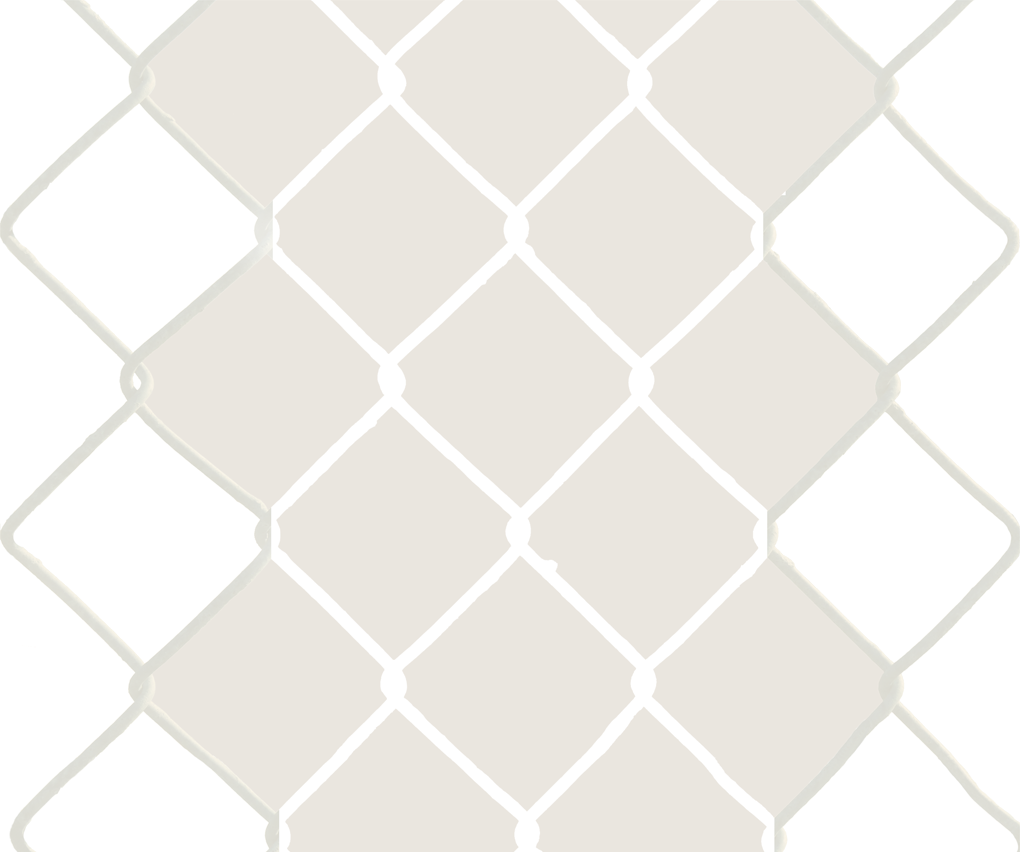Porous Borders Festival
organized by The Hinterlands (Liza Bielby and Richard Newman) in collaboration with Power House Productions's Carpenter Exchange (Mitch Cope and Gina Reichert)
16 - 17 May 2015
Hamtramck, Michigan
http://www.porousbordersfestival.org/
When I was asked to participate in the Porous Borders Festival that was to be held in May, 2015, near the border between Detroit and Hamtramck, I didn’t say yes right away. Porous Borders?? Some kind of new wackiness from new-white-kids-in-Detroit? Were they gonna stage border clashes on immigration, or stand their ground at the boundary of the cities or something? Advocate no borders in municipalities that have tried to maintain their boundaries for generations??
I said yes, hoping this would sort itself out, but I didn’t get started on my presentation for a while, not able to get my mind around exactly what this festival was about. Finally, over a Trinosophes brunch with Liza Bielby and Richard Newman, I was impressed with their intelligent, careful contemplation of the history of the locale, and moved by their earnestness, their desire to acknowledge but reach past the boundaries of the two cities – and other boundaries, too. I was reminded of my own younger years – starting in the late 60’s - and those great days of the movements for change in Detroit.
As it turned out, the Porous Borders Festival was one of the best “new Detroit” experiences that I’ve yet had. It was wacky – but also whimsical, artful, playful, musical, physical, intelligent - and deeply engaged with the community in which it was held. For underneath the surface of the news reports and social media opining on redevelopment/gentrification/Move to Detroit! there is sometimes a deep angst, a simmering conflict – often unspoken, sometimes not – between new and old Detroiters in the neighborhoods in which they are now beginning to co-exist.
I believe that, because of the reflection and discernment of the organizers, this was an event that did not have me cringing as I stood in a neighborhood of color with the “new people” doing all manner of what might be regarded by the community as weirdness at best, and pure devilishness at worst – and sometimes, just plain disrespect. Porous Borders was an event that seemed to emanate from the best impulses of community itself, so attuned were the planners with their environs.
Although there is commonly a harmonious synthesis of new and long-time residents in our neighborhoods there can be a profound disconnect between the activities of artists/progressives/activists and their new communities – and not just a white/black divide, either. I remember my own occasional self-consciousness as a young person passing out leaflets or performing for any number of causes, discomfited by my awareness at how disconnected we sometimes were from the neighbors for whom we purported to agitate, as they looked askance at our remonstrations on their behalf (figs. 1 & 5).
| figure 1 |
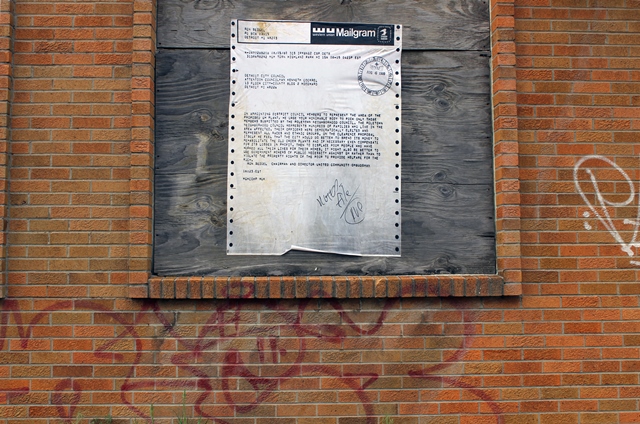 |
Detroit Homeland Security (Bryce Detroit, Kate Levy and Shanna Merola). Don't Ignore the Messenger - Detroit Homeland Security. 17 May 2015. Part of Porous Boders Festival. Photo courtesy stephen garrett dewyer
|
In today’s Detroit, with whites moving into the city – and not just into Downtown, but also into “the ‘hood” – such a disconnect can create a large cultural chasm in a neighborhood, or on a block. In Hamtramck, where many nationalities share the same municipal space, some of the differences may be less jarring.
In writing about Porous Borders I’m using the term Detroit broadly (chauvinistically, perhaps), for the fest was mostly in Hamtramck, a city within the city of Detroit. It was a primarily Polish enclave during the booming automotive days with the Dodge Main Plant as its main industrial anchor. Most Blacks who lived there learned to speak at least a little Polish. Today, with the movement of most Poles to the suburbs and the assimilation of a number of Middle Eastern and other nationalities, it is regarded as one of the most multi-national cities in the U.S.
Porous Borders organizers crafted activities that drew the interest of those in their surroundings, without ignoring or patronizing the working class environment in which the festival was held. The plebian nature of Hamtramck, with its mostly still-intact and well-kept blocks of frame houses and small brick bungalows, does not lend itself to flights of artistic arrogance – a factor clearly known by the festival’s organizers.
The boisterous, jubilant Detroit Party Band led a parade, drawing the attention of those within earshot – not as an infringement upon the community, or treating them as invisible – but as a celebration of the life in the neighborhood and respect for its people.
The fastest oil-change contest (fig. 2)! A nail polish booth! These and other whimsical, imaginative Porous Borders events drew folks from the neighborhood in a way that revealed just how accessible art can be – without patronization, dumbing down, nor smug, tongue in cheekiness, but with genuine appreciation for the joy of artful engagement at many levels. The nail polish booth engaged excited kids – and some adults - in fingernail art, and they lined up to express their creativity (fig. 3).
| figure 2 |
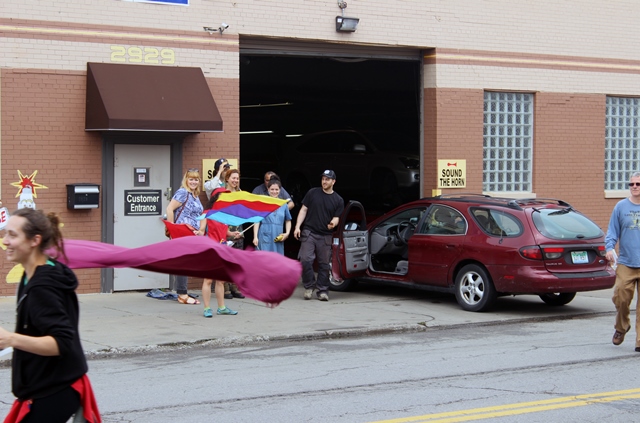 |
| The Hinterlands (Richard Newman and Liza Bielby). A2Z Auto Center vs. The Mechanic Shop Inc.: Oil Change Race. 16 May 2015. Eastern corners of Carpenter and Campau, Hamtramck, Michigan. Part of Porous Boders Festival. Photo courtesy stephen garrett dewyer |
Artist Chido Johnson led a parade of his “wire cars,” inspired by his youth in Zimbabwe, and seeing them roll on the streets of a real motor city accentuated the irony of his little cars on an avenue that was once full of traffic, in a city once dominated by real automotive production. His parade of cars was even more affecting than his Detroit Boom City show in June at the Pickle Factory.
| figure 3 |
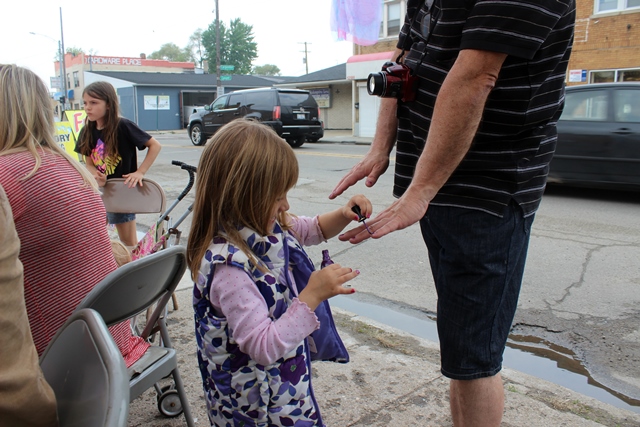 |
| Katie Grace McGowan. Neighborhood Nailz. 16 June 2015. Walter's Shopping Place, 12199 Conant, Hamtramck, Michigan. Part of Porous Boders Festival. Photo courtesy stephen garrett dewyer |
I finally visited the north Hamtramck arthaus, Popps Packing, founded by artists Faina Lerman and Graem Whyte. An installation there that rivaled any in downtown venues was the INNER_CORE: New Works By Tom Phardel show. That a sophisticated exhibit of such significant sculptural work was embedded in proletarian Hamtramck, and on the itinerary for the Porous Borders Fest, bespeaks a formalized reflection of the long-time presence of fine arts and artists who create and dwell in the neighborhoods.
Several of the Porous Borders events were at The Playhouse, one of the renovated arts spaces implanted in working class blocks by Mitch Cope and Gina Reichert of Power House Productions. There were performances that drew from the artist community - both new and long-timers - and from the neighborhoods; one in which two young Bangladeshi women led a fascinating talk, recounting their growing up in the so-called melting pot of Hamtramck. Hamtown is acclaimed as a multi-ethnic city; however, the women recounted that the varied nationalities – numerous though they may be - have little close interaction with each other - and all either coexist within - or function outside of - the Detroit Black/White matrix (fig. 4).
| figure 4 |
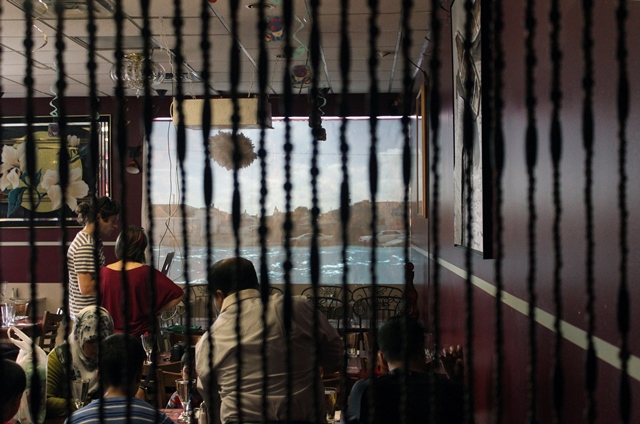 |
Oren Goldenberg and Erin Gilley. Border Portals. 17 May 2015. Record Graveyard, 2610 Carpenter, and Reshmi Sweets, 12170 Conant. Part of Porous Boders Festival. Photo courtesy stephen garrett dewyer |
They projected Hamtramck as a richly diverse cultural potluck, rather than a melting pot, and their stories of their experiences were compelling. Most noteworthy was the intense attention of the audience, who asked thoughtful, probing questions. It was gratifying to see real connections being made in the attempt to learn about other cultures.
Detroit’s North End was the defacto western border of the festival and the artists and cultural activists there contributed their usual sharply defined event at the Red Door Gallery – a big, artful renovated space owned by social entrepreneur and Detroit elder Roger Robinson.
North End artist and activist Halima Cassells headed a “speed-dating” party - but instead of angling for a “date,” participants moved from one “player” to another, learning all they could about their new acquaintances in the few minutes allotted before moving on. It was a clever way to introduce newcomers to one another, and most importantly, to pair longtime residents with newcomers as a way to break down yet another “border.”
| figure 5 |
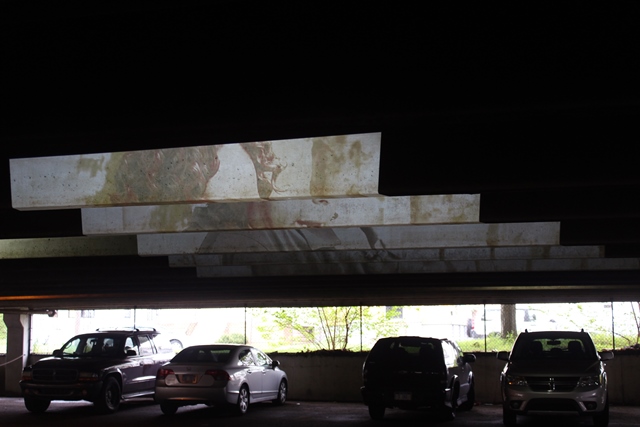 |
Detroit Homeland Security (Bryce Detroit, Kate Levy and Shanna Merola). Don't Ignore the Messenger - Detroit Homeland Security. 17 May 2015. Part of Porous Boders Festival. Photo courtesy stephen garrett dewyer
|
There were many collaborators on Porous Borders; should I try to name them all, I am sure to be guilty of omission. For sure, the planners acted from a place of good intention, a real attempt to respect the communities in which the fest took place. Lauren Hood and Ryan Barrett told stories of past lives in the neighborhood. There were collaborations with local bakeries and businesses, The Greater Missionary Baptist Church, the Downtown Boxing Gym, yoga groups – and a write a letter and send a book project to inmates at the Dickerson Facility – an un-porous border, for sure.
There were many events; I’m only mentioning a few. It was no small thing to pull together such a community celebration, with so many presentations and locations, but they did it, and well. Besides all this, it was fun.
Porous Borders culminated in a dinner/potluck/picnic on a cared-for green lot across from Popps Packing (fig. 6). I’ve experienced times, in my ever increasing years on earth, that I can only describe as transcendent “Detroit moments”, usually cultural events so resonant of the essence of the city that they enter into the canon of “you just had to be there” significant Detroit events. This potluck dinner was one of them. Not a huge gathering, but one that, if any one event could, showed a vision of the future of life in the two cities of Hamtramck and Detroit.
| figure 6 |
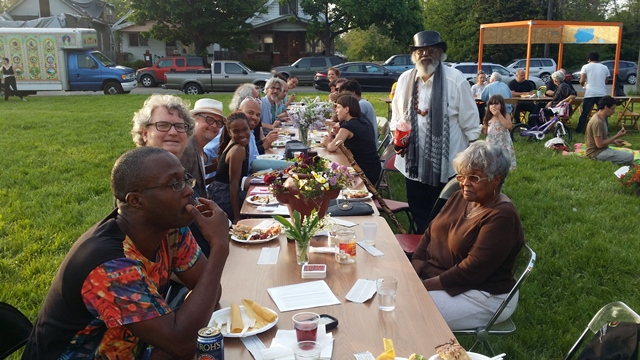 |
Porous Borders dinner/potluck/picnic across from Popps Packing
17 May 2015
Photo courtesy Marsha Music |
The picnic was by and for the many who helped with setup or logistics, and performed or otherwise participated in Porous Borders. It was one of those glorious, almost-summer balmy days for which we wait long months in weather-challenged post-winter Detroit. There were at least fifty people, set around long, mix-matched card tables and such, and a head table laid out with food, drink and desserts.
I was especially captivated by the music that they played; rather than white rock music or hip hop of a kind that can be cacophonous and annoying to many especially older community people (uh, like me), all evening they played a cool artsy/jazzy/new age mix of sounds which wafted down the block quite nicely. Neighbors nodded their heads as they drove by. No one I saw looked crossed-eyed at our gathering because of the music.
The potluck, like the fest, was diverse – admittedly, in the way that diverse has come to mean in the “new Detroit” - that is, not nearly representative of the actual over 80% Black population in the city - but surely more than at many arts events. What was significant was the tone of inclusion; the intentionality, as they say; and the transference of that intent into a real inclusiveness. Though, the idea of entities “including” folks of color in events in folks’ own communities is absurd and even noxious; nevertheless, consciousness around diversity is tantamount, and was in evidence here.
Perhaps the organizers have a more egalitarian view because this event and many of these artists are based in Hamtramck, with its sort of neo-colonial relationship to Detroit; continually (along with Highland Park) fighting to maintain independence from the larger city. Maybe the huge immigrant population of Hamtramck of peoples of color compels this core of artists to reject a white tunnel vision not uncommon in many other endeavors in the “new Detroit.” Or maybe these artists are just good people. Regardless, many Detroit area arts entities would do much to learn from their example.
| figure 7 |
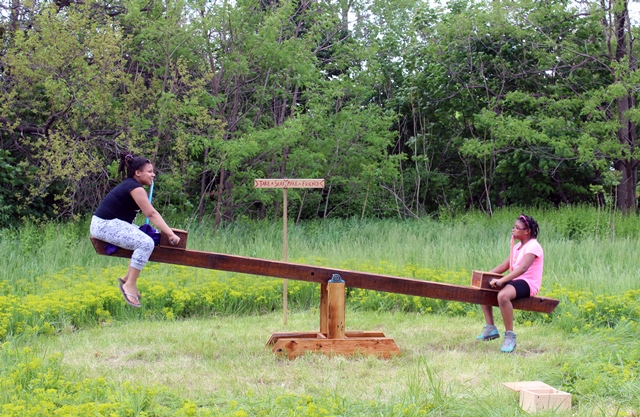 |
Eitan Sussman. She Saw Seesaws by the Sallan Shore. 16 May 2015. Lots next to 2037 Carpenter, Hamtramck, Michigan. Part of Porous Boders Festival. Photo courtesy stephen garrett dewyer
|
After the potluck began, an elder black woman came out of her nearby home and walked across the street and over to the table, taking it all in. She obviously knew some of the organizers and made herself at home. Watching the people and dogs and food and the atmosphere of peace and camaraderie, she continually said, to herself - and to whoever was in earshot - “Thank you Jesus, thank you Jesus”.
I understood. Many newcomers underestimate the trauma that has been visited upon our communities, and the deep anguish left in its wake. Many only know distressed or dilapidated neighborhoods the way that they are now - and not the way they were - and have no idea how much pain the remaining neighbors have experienced in the transitions of their blocks down through the years.
It was obvious to me that this woman had witnessed and endured much in the decades that she had been holding onto and caring for her home, in the face of encroaching dereliction. Many long-time Detroiters have survived the scourge of drugs, fire, crime and foreclosure. Now, finally having peace, they welcome the new people, some who come with loud, obnoxious, druggy partying – bacchanals, as I say. Many long time neighbors tolerate outdoor art that they regard as aesthetic infringements on their idea of community.
But at Porous Borders, this elder of the community was grateful for this scene of peaceable, respectful people, and the art that they have brought with them, as was I. Many arts, events or redevelopment entities have been unable – or are unwilling – to successfully involve the community, outside of its cultural activists, if that.
The Slow Roll mass bike ride – now 6,000 strong - is a stunning exception, with suburbanites and folks from around the state and country riding through Detroit - with Detroiters. Neighborhoods that were a fearful, dark haze to outsiders, hurriedly driven past, become living places with living people. Residents become more than ciphers; no longer “invisible” to non-residents with whom they had previously little to no contact. Bikers witness the variety of neighborhoods in the city, instead of ruin porn tropes. From the beginning, the leaders were clearly tapped into the same well of diversity – of race and class - as was Porous Borders, and the riotous fun on the weekly rides is evidence of the possibilities of “life in the big city.”
I knew what the Porous Borders gathering – this manifestation of the possibility of a viable future for her community - meant to the neighbor woman at the potluck dinner. The finale of Porous Borders was an amiable, engaging evening, and a few more neighbor folks drifted over to share in the night.
New, white residents to the neighborhoods are often startled by the welcome that they experience in the community; the care and concern extended by the old-timers. Many of those elders remember well the reception they received when they moved into the neighborhood – most often, the only welcome wagons in sight were the moving trucks that cleared the blocks of white people, sometimes almost overnight.
Yet as whites today move further into the neighborhoods, most – that I know - find that they are more than accepted in their new communities – as long as there is mutual respect. At the Porous Borders potluck, as with the festival, it was peace, love, art, community, and R.E.S.P.E.C.T. – another border transcended in Hamtramck and Detroit.
[Btw, at Porous Borders I presented a showing of “Finally Got the News”, a documentary film about the radical labor organizations DRUM and the League of Revolutionary Black Workers. Their struggle was sparked in Hamtramck’s Dodge Main Plant. The compelling sincerity of Bielby and Newman, during our first meeting, moved me to want to recount my own youth spent in this legendary organization almost 50 years ago. Ana Kukovic, another young artist intellectual, midwifed my essay on the League into existence for the companion zine for the Porous Borders Festival.]
|
|

